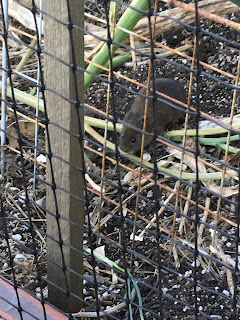February's garden notes:
I'm sure you've noticed the signs of spring everywhere. In our gardens the tulips, daffodils, irises, and hyacinth are all open. That means it's not too early to think about planting- let nature water your garden for you and take advantage of establishing early season plantings. The February crop list includes arugula, beets, broccoli, cabbage, carrots, cauliflower, chard, collard greens, fava beans, kale, leeks, lettuce, mustard greens, onion seeds and sets, peas, radish, spinach, strawberries, & turnips. We continue to visit the gardens for plot checks and to distribute compost. Coming up: 3/14- West Washington, 3/21- South Baker Beach, 3/28-MacArthur... all from 2-4pm.
Please come out and work with us in the gardens! Weekend hours:
Ft. Scott February Volunteer Program Saturday 2/25, 10am-noon (please RSVP)
MacArthur compost and mulch: Saturday 2/25, 1:30-3:30pm
South Baker Beach compost: Saturday 3/11, 10am-noon
Baker Beach compost: Saturday 3/11, 1-5pm
West Washington compost: Saturday 3/25, 10am-noon
Portola compost: Saturday 3/25, 1:30-3:30pm
I'm sure you've noticed the signs of spring everywhere. In our gardens the tulips, daffodils, irises, and hyacinth are all open. That means it's not too early to think about planting- let nature water your garden for you and take advantage of establishing early season plantings. The February crop list includes arugula, beets, broccoli, cabbage, carrots, cauliflower, chard, collard greens, fava beans, kale, leeks, lettuce, mustard greens, onion seeds and sets, peas, radish, spinach, strawberries, & turnips. We continue to visit the gardens for plot checks and to distribute compost. Coming up: 3/14- West Washington, 3/21- South Baker Beach, 3/28-MacArthur... all from 2-4pm.
Please come out and work with us in the gardens! Weekend hours:
Ft. Scott February Volunteer Program Saturday 2/25, 10am-noon (please RSVP)
MacArthur compost and mulch: Saturday 2/25, 1:30-3:30pm
South Baker Beach compost: Saturday 3/11, 10am-noon
Baker Beach compost: Saturday 3/11, 1-5pm
West Washington compost: Saturday 3/25, 10am-noon
Portola compost: Saturday 3/25, 1:30-3:30pm
Our Spring Equinox Pizza Potluck is on March 20-RSVP here
In case you didn't know, we have a great resource for gardening in San Francisco right in the Inner Sunset-Garden for the Environment has been teaching SF to garden and compost for 20 years! A full list of their spring workshops can be found later in this post. Click to read more about GFE and other places to learn about growing veggies in San Francisco:










